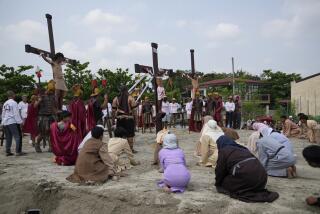Did a Tragic Blunder Slay Sri Lanka’s ‘White Tiger’? : Civil war: An American priest is missing and presumed dead. Friends say he got caught in the middle of the nation’s savage ethnic conflicts.
- Share via
BATTICALOA, Sri Lanka — Father Eugene Hebert, an American Jesuit, was riding down the road on his red motor scooter last month, and a Red Cross nurse waved at him from a passing van. He has not been seen since.
Almost any groups involved in the chaos of Sri Lanka’s communal hatreds and savage civil war might be responsible for his disappearance.
Hundreds of people were killed on Sri Lanka’s east coast during August in ethnic slaughter among Tamils, Muslims and Sinhalese.
Father Hebert, neither participant nor bystander, got caught in the middle.
When last seen, the 67-year-old priest was returning to the technical school at St. Michael’s College in Batticaloa, 135 miles east of Colombo, capital of Sri Lanka.
Bertram Francis, a Tamil student, was riding on the passenger seat. The nurse waved to them 12 to 15 miles outside town. That was Aug. 15.
Father Harry Miller, a fellow Jesuit who came here with Hebert 42 years ago, said this is what he thinks happened: “There was someone somewhere who took exception to this Tamil boy and tried to take him away. Father Hebert, being what he was, defended the boy to the death.”
A U.S. diplomat described Hebert, one of five foreign priests at St. Michael’s, as the first American casualty of the 7-year-old civil war. He is presumed dead, although neither his body nor the scooter has been found.
About 400 people, most of them Tamils, have been reported missing in this eastern district in the new round of ethnic war that began in June, Miller said. He accused the army in Hebert’s case, but said he believed it was a tragic blunder.
Hebert arrived in Sri Lanka from Jennings, La., in 1948, the year the paradise island then known as Ceylon became independent of Britain. He was a teacher, parish priest, director of the technical school and the toughest basketball coach in the country.
Some army officers called him “a white Tiger” because he interceded for Tamil youths detained on suspicion of aiding guerrillas of the Liberation Tigers of Tamil Eelam.
“He was a very popular man in this area,” a Tamil businessman said. “He was the only priest who wouldn’t get off his bike at an army checkpoint.”
Hebert “always had a strong conviction that he was safe,” Miller said.
A few days before his disappearance, after a Tamil priest was stoned and beaten by a Muslim mob, Hebert turned to Miller and another priest and said: “You know, sooner or later one of us will go (be killed).”
When the conflict between the Sinhalese, who dominate Sri Lanka, and the minority Tamils became acute in the early 1980s, Hebert and some other Roman Catholic priests warned of a blood bath and counseled conciliation.
The Tamils, 18% of Sri Lanka’s 16 million people, claim discrimination by the Sinhalese, who make up 75%.
Since fighting resumed June 11, the army has regained control of the towns and most roads in the east, conceding the jungle and remote villages to the Tigers.
In Batticaloa, a town of 40,000 Tamils between the sea and a lagoon, life deteriorated after the army took over, according to Miller and Tamil residents.
Schools are shut. Most Tamil-owned businesses are closed, and others open only in the mornings.
Food is scarce and arrives only sporadically by truck convoy. People stay indoors after 2 p.m. in a voluntary curfew born of fear.
Young Tamils dread what they call arbitrary arrest. Dozens of unidentifiable bodies have been seen burning in the streets.
A senior army officer, who spoke in an unauthorized interview and refused to let his name be used, denied any impropriety. He said the bodies of Tigers killed in skirmishes were burned because there was no one to bury them.
While a reporter was visiting a Tamil politician, soldiers entered the house, searched it, checked the identity papers of his employees and took a 19-year-old away for questioning. The youth was released soon afterward.
Muslims and Tamils often live in adjacent villages outside Batticaloa. They speak the same language and, apart from religion, share the same culture.
Most Tamils are Hindus, but many in the Batticaloa area are Christians. Except for occasional trouble that began about two years ago, the Tamils and Muslims had lived together harmoniously.
The resumption of war in June began a period of brutality, including decapitation and mutilation, that has exceeded anything before it.
Different sides trace it to different events, and each community professes innocence.
One of the worst massacres took place Aug. 11 in Eravur, a Muslim village just north of Batticaloa. Attackers suspected of being Tigers killed 127 people by shooting or hacking them to death.
Four days later, Eravur was on Hebert’s route home to Batticaloa from Valachchenai, 15 miles north, where he met with Tamil priests and nuns who felt threatened by the violence.
Tamils, fleeing Muslim vengeance and army arrests, had abandoned the villages between Eravur and Valachchenai, and there was no traffic on the road, Miller said.
“At first, everyone concluded it was the Muslims who killed him. Now I don’t think so,” he said. If the Muslims were responsible, Miller added, it would have been another incident of mob violence and could not be kept secret.
“He never got to Eravur,” Hebert’s friend said. “There was only one other operating agent in that area, and that is the army,” he said.
More to Read
Sign up for Essential California
The most important California stories and recommendations in your inbox every morning.
You may occasionally receive promotional content from the Los Angeles Times.













